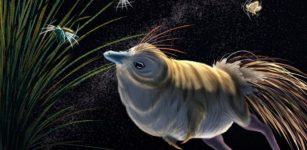Fossils Of A 22-Million-Year-Old Gigantic Carnivore Larger Than A Polar Bear Discovered In Kenya – It’s A New Species
Eddie Gonzales Jr. – MessageToEagle.com – Paleontologists have discovered a new species of meat-eating mammal. Fossils of a gigantic 22-million-year-old carnivore were found in Kenya.
This was not a “kitten” you could cuddle with! This animal was larger than a polar bear, with a skull as large as that of a rhinoceros and enormous piercing canine teeth.
Known as Simbakubwa kutokaafrika, this gigantic carnivore lived alongside early apes and monkeys.
Simbakubwa kutokaafrika, a gigantic carnivore known from most of its jaw, portions of its skull, and parts of its skeleton, was a hyaenodont that was larger than a polar bear. Credit: Illustration by Mauricio Anton
The fossils of the animal were unearthed decades ago, but no-one thought of examining them closer. The bones were placed in a drawer at the National Museums of Kenya and not given a great deal of attention until Ohio University researchers Dr. Nancy Stevens and Dr. Matthew Borths rediscovered them, recognizing their significance.
“Opening a museum drawer, we saw a row of gigantic meat-eating teeth, clearly belonging to a species new to science,” researchers said in a press statement.
Simbakubwa is Swahili for “big lion” because the animal was likely at the top of the food chain in Africa, as lions are in modern African ecosystems. Yet Simbakubwa was not closely related to big cats or any other mammalian carnivore alive today. Instead, the creature belonged to an extinct group of mammals called hyaenodonts.
Hyaenodonts were the first mammalian carnivores in Africa. For about 45 million years after the extinction of the non-avian dinosaurs, hyaenodonts were the apex predators in Africa.
See also:
Amphibious Whale That Could Both Swim And Walk On Land – Peru Discovery
Monster Bird ‘Kumimanu’ Was A Giant Penguin That Reached Human Height
Meet Quetzalcoatlus – World’s Largest Flying Animal Had A Wingspan Of Up To 52 Feet (15.9 m)
Goliath Birdeater: World’s Largest Spider Can Grow As Long As A Child’s Forearm
Then, after millions of years of near-isolation, tectonic movements of the Earth’s plates connected Africa with the northern continents, allowing floral and faunal exchange between landmasses. Around the time of Simbakubwa, the relatives of cats, hyenas, and dogs began to arrive in Africa from Eurasia.
The species name, kutokaafrika, is Swahili for “coming from Africa” because Simbakubwa is the oldest of the gigantic hyaenodonts, suggesting this lineage of giant carnivores likely originated on the African continent and moved northward to flourish for millions of years.
Ultimately, hyaenodonts worldwide went extinct. Global ecosystems were changing between 18 and 15 million years ago as grasslands replaced forests and new mammalian lineages diversified. “We don’t know exactly what drove hyaenodonts to extinction, but ecosystems were changing quickly as the global climate became drier. The gigantic relatives of Simbakubwa were among the last hyaenodonts on the planet.
This discovery will help scientists to better understand how species adapt to climate change.
Written by Eddie Gonzales Jr. – MessageToEagle.com Staff Writer











